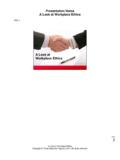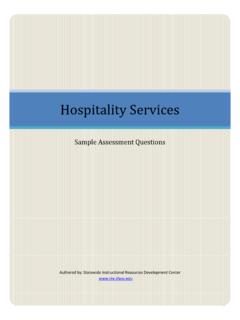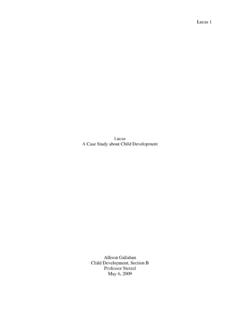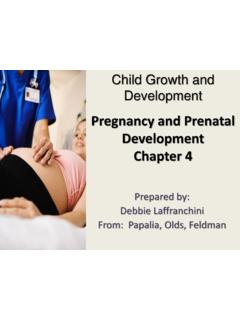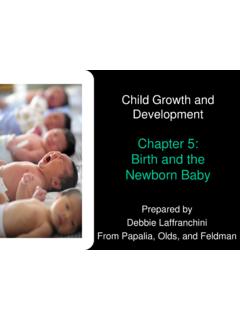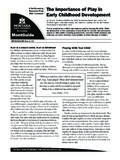Transcription of 100 Human Growth and Development Questions
1 Human Growth and Development 100 Sample Assessment Questions Authored by: Statewide Instructional Resources Development Center Sample Assessment Questions : Human Growth and Development Copyright Texas Education Agency, 2013. All rights reserved. Page1 25 Recall/Reproduction Assessment Questions 1. All of the following are periods of prenatal Development except: a. germinal b. embryonic c. fetal d. postpartum 2. Lack of prenatal care increases the risk of all of the following except: a. infants with low birth weight b. child abuse c. increased infant mortality d. preterm births 3. All of the following have been found to endanger the unborn child except: a.
2 Saunas and hot tubs b. PCB-polluted fish c. carbon monoxide d. computer monitors 4. What frequently happens between adolescents and parents? a. They compete for family resources b. They violate one another's expectations c. They reject one another's personal space d. They get along well because they share similar levels of cognitive Development 5. According to Centers for Disease Control and Prevention, what percentage of American adults 20 39 years of age are obese? a. 8% b. 30% c. 29% d. 22% 6. The main cause of death for individuals in middle adulthood is: a. heart disease b. diabetes c.
3 Cancer d. cerebrovascular disease 7. A middle-aged adult who begins to hold books or other items at a distance in order to focus on the image may be experiencing the age-related deterioration in vision known as: a. presbyopia b. cataracts c. presbycusis d. glaucoma 8. Which of the following is Erikson's stage for middle adulthood? a. generativity versus stagnation b. intimacy versus isolation c. autonomy versus shame d. integrity versus despair Sample Assessment Questions : Human Growth and Development Copyright Texas Education Agency, 2013. All rights reserved. Page2 9. What is the single largest factor determining the trajectory of an adult's mental or physical status in the years beyond age 65?
4 A. Health b. Personality c. Socioeconomic status d. The size of the social support network 10. Which of the following is not a risk factor for the Development of depression in late adulthood? a. Poverty b. Female gender c. Personality type d. Health status 11. Erikson's psychosocial theory: a. is a behavioral theory of Development b. is a stage theory of Development c. is a systems theory d. is widely used in psychiatric treatments 12. The environmental conditions that influence Development are called: a. ethology b. ecological systems c. socio-cultural d. nurture 13. Which developmental theory was based on how children learn by observing and imitating others' behavior?
5 A. Classical b. Operant conditioning c. Psychosocial d. Social learning theory 14. Which researcher believed that children adjust their understanding as they learn about the world? a. Vygotsky b. Skinner c. Piaget d. Bandura 15. Piaget's theory of cognitive Development began with his study of: a. rhesus monkeys b. mollusks c. children d. dogs 16. What nutrient has been shown to reduce the risk of neural tube defects in infants if consumed by the mother at least one month before conception and during the early weeks of pregnancy? a. Calcium b. Vitamin C c. Zinc d. Folic acid Sample Assessment Questions : Human Growth and Development Copyright Texas Education Agency, 2013.
6 All rights reserved. Page3 17. Which of the following fish should be limited, because of mercury content, to no more than 6 oz. per week for pregnant, nursing, or women of childbearing age who may become pregnant? a. Salmon b. Albacore tuna c. Catfish d. Cod 18. Which of the following is acceptable for a pregnant woman to consume daily? a. A can of soda b. Swordfish c. Green tea d. Raspberry tea 19. How many daily minutes of moderate exercise are recommended during pregnancy by the American College of Obstetricians and Gynecologists for women without medical complications? a. 20 minutes b.
7 45 minutes c. No exercise is recommended during pregnancy d. 30 minutes 20. The average 8-year-old will probably still have difficulty: a. riding a bike b. jumping rope c. judging speed d. aiming a ball 21. The preschool child has the following daily nutritional needs: a. meat - 2-3 servings b. fruits and vegetables - 5 or more servings c. milk - 3 glasses d. all of the above 22. What provision provides the local authority's key duty to investigate suspected child abuse? a. S. 11 Children Act 2004 b. S. 31 Children Act 1989 c. S. 47 Children Act 1989 d. S. 17 Children Act 1989 23. Which Act created the office of Children's Commissioner?
8 A. The Children Act 2004 b. The Education Act 1996 c. The Care Standards Act 2000 d. The Children Act 1989 24. What body has replaced Area child Protection Committees? a. Children's Trusts b. Children's Services Authorities c. Local Safeguarding Children Boards d. Children Safeguarding Committees Sample Assessment Questions : Human Growth and Development Copyright Texas Education Agency, 2013. All rights reserved. Page4 25. Environmental factors that shape Development include all of the following except: a. quality of learning b. intelligence c. quality of nutrition d.
9 Culture Recall/Reproduction Assessment Key 1. D 2. B 3. D 4. B 5. D 6. A 7. A 8. B 9. A 10. C 11. B 12. D 13. D 14. C 15. B 16. D 17. B 18. A 19. D 20. C 21. D 22. C 23. A 24. C 25. B Sample Assessment Questions : Human Growth and Development Copyright Texas Education Agency, 2013. All rights reserved. Page5 25 Skill/Concept Assessment Questions 1. Adolescents' cognitive abilities differ from those of children primarily in that, unlike children, an adolescent s thinking is not necessarily tied to ___. a. logic b. abstract ideas c. fantasy d. concrete events 2. Adolescents develop the ability to use ___, or the ability to draw logical conclusions based on a set of facts or premises.
10 A. inductive reasoning b. abstract reasoning c. relational reasoning d. deductive reasoning 3. Early-maturing adolescents often date at an earlier age than their later-maturing friends. For females, at least, this early social involvement may be welcomed uneasily by the adolescent, because many adolescent females are: a. unprepared for puberty b. emotionally secure c. unattractive d. not interested in heterosexual interactions 4. Conflict between adolescents and parents is typically strongest in early adolescence, and may be a healthy aspect of the Development of: a. autonomy b.
